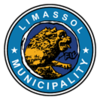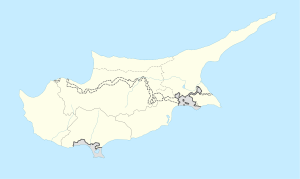Lemesos
|
Limassol Λεμεσός / Limasol |
||
|---|---|---|
 |
||
|
||
| Coordinates: 34°40′N 33°02′E / 34.667°N 33.033°E | ||
| Country |
|
|
| District | Limassol District | |
| Government | ||
| • Mayor | Nicos Nicolaides | |
| Area | ||
| • City | 41.87 km2 (16.17 sq mi) | |
| Population (2011) | ||
| • City | 101,000 | |
| • Urban | 165,000-176,700 | |
| Time zone | EET (UTC+2) | |
| • Summer (DST) | EEST (UTC+3) | |
| Postal code | 3010–3150 | |
| Website | www.limassolmunicipal.com.cy | |
Limassol (/ˈlɪməsɒl/; Greek: Λεμεσός [lemeˈsos]; Turkish: Limasol or Leymosun) is a city on the southern coast of Cyprus and capital of the eponymous district. Limassol is the second largest urban area in Cyprus, with an urban population of 160,000–176,700. Limassol has been ranked by TripAdvisor as the 3rd up-and-coming destination in the world, in its Top 10 Traveler’s Choice Destinations on the Rise. The city is also ranked 87th worldwide in Mercer's Quality of Living Survey (2015).
Limassol was built between two ancient cities, Amathus and Kourion, and during Byzantine rule it was known as Neapolis (new town). Limassol's historical centre is located around its medieval Limassol Castle and the Old Port. Today the city spreads along the Mediterranean coast and has extended much farther than the castle and port, with its suburbs stretching along the coast to Amathus. To the west of the city is the Akrotiri Area of the British Overseas Territory of Akrotiri and Dhekelia.
The city of Limassol is situated between the ancient cities of Amathus and Kourion (Curium). Limassol was probably built after Amathus had been ruined. However, the town of Limassol has been inhabited since very ancient times. Graves found there date back to 2000 BC and others date back to the 8th and 4th centuries BC. These few remains show that a small colonisation must have existed which did not manage to develop and flourish. Ancient writers mention nothing about the foundation of the town. In 85 BC, Armenian emperor Tigranes the Great (Armenian: Տիգրան Մեծ Tigran Mets; Greek: Τιγράνης ὁ Μέγας Tigránes ho Mégas) had reached Limassol in order to establish security and protection of local Greek allies against Rome in a result followed by his conquest of Syria, Lebanon and Anatolia.
...
Wikipedia


